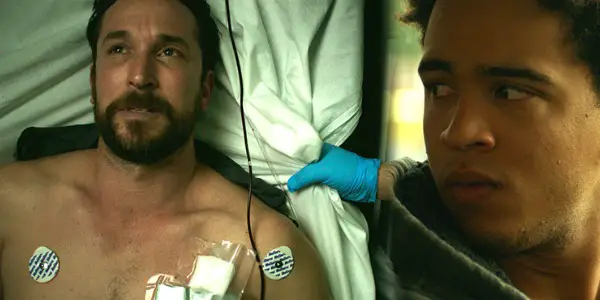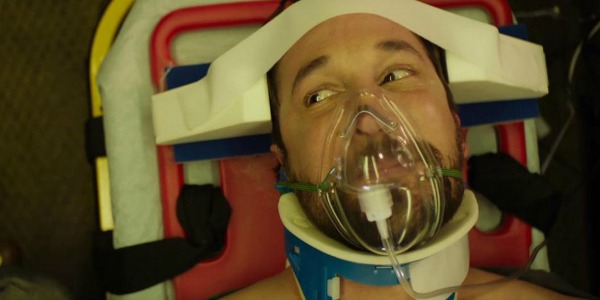SHOT: A Gripping, Timely Pro Gun-Control Thriller

Alex Arabian is a freelance film journalist and filmmaker. His…
Shot tells the story of an expert sound mixer named Mark Newman (played ingeniously by Noah Wyle, also an executive producer on the film), who is accidentally shot by a bullied kid named Miguel (Jorge Lendeborg Jr. in a star-making performance, previously seen in Brigsby Bear).
It is unlike anything you have seen in theaters or elsewhere all year, and one of the most uniquely structured and unpredictable films to have come out this century. Directed by Jeremy Kagan (The Chosen), who also provided the story, and written by Anneke Campbell and Will Lamborn, this low-budget film uses intense realism to convey the timely theme of gun control and makes a powerful plea to put a stop to gun violence.
In America in 2017, there were 15,558 gun violence deaths and 31,161 gun violence injuries, not including the roughly 22,000 suicides by firearm annually. Gun control and gun violence have become such a rampant problem in the U.S., that the majority of homicides are now committed using a firearm every year.
Still, a large group in our government and of our citizens still refuse to admit that gun control and gun violence are correlated; it’s an antiquated, backwards viewpoint that needs to be extinguished. Shot makes this point by exploring how drastically three lives are affected by one specific incident of gun violence: the victim (Mark), his wife, Phoebe (Sharon Leal, Supergirl, Dreamgirls), and the perpetrator (Miguel).
Visceral Realism
After Mark is shot, Kagan’s unadulterated lens creates a realism that exceptionally captures the incident and its aftermath; teleporting the viewer to the moment with the help of disembodied voices of the bystanders surrounding him, as he’s bleeding out on the sidewalk while his wife desperately tries to stop said bleeding. It encapsulates the detached cell phone craze and social media age of America in one scene: somebody is injured while various people give him advice to stop the bleeding, but nobody helps him; rather, everyone either leaves the scene or pulls out their phones so as to capture the grisly spectacle. One person even says out loud, “I don’t think he’s going to make it” while they’re filming.
Kagan’s effective use of periodic split-screen shows both Wyle’s Mark’s struggle to survive as well as Lendeborg Jr.’s Miguel’s moral struggle with guilt and doing the right thing. The style of direction is very in-your-face once the paramedics arrive, with a clever use of POV style giving the viewer the same sense of claustrophobia, panic, and confusion that Mark must be feeling. The audience also sees the commotion from a distance from Phoebe, in sporadic POV shots, adding to the part-Direct Cinema-esque style of Shot.

In the first hour of Shot, there are no filler scenes, no time jumps, flashbacks, or narrative stumbles; Kagan takes us on a disturbing journey through two men and one woman’s points of view. Mark’s plight is particularly harrowing, from the gunshot, to the ambulance, to the hospital, to his shaky recovery. The audience can feel his pain through Wyle’s raw acting, occasionally laughing nervously at his character’s admirable maintaining of a sense of humor through such a dire situation. Most of all, through Campbell and Lamborn’s script and strong performances, there is a biting realism through reaction, emotion, and human response.
An Intriguing Narrative Structure
It’s extraordinary how Shot’s story can have such vast character development with such a unique narrative structure, as the audience is simply present with the victim and the perpetrator in real time for about an hour of the 89-minute runtime. One could argue that by spending so much time with these two people in their respective fight or flight situations, the viewer gets to know them more than most films’ narratives would allow for.
In a sense, Miguel is going through almost as much pain as Mark is, as this wasn’t a senseless act of violence and he isn’t an irrational criminal. This shooting was an unfortunate accident, and Miguel, who is frequently bullied for being smart and avoiding trouble, was peer pressured into taking the gun for intimidation purposes by his cousin.
For a low-budget film, the sound, like Mark’s applaudable job performance as a sound mixer, is incredible and Jacek Laskus’s cinematography incredibly inventive. Specifically, scenes where Mark reminisces on past moments with Phoebe as he becomes increasingly medicated and on the brink of death, hallucinating fading memories of his past, are potent and well-integrated into Shot. The film smoothly jumps from drama, to thriller, to horror while Mark is being prodded, cut, and operated on in the hospital, back to emotionally resonant drama, to a gut-wrenching ending.

Shot is graphic but not gratuitous; Kagan doesn’t hold back in showing every detail in the hospital during surgery as the doctors and nurses struggle to save Mark’s life, adding to the gritty realism. Kagan also doesn’t shy away from showing Phoebe’s struggle as her husband lies on the operating table in the emergency room. Using, at times, a three-way split screen, this is as much a triunal character study as it is a dual character study between Miguel and Mark. At times, the juxtaposition between Miguel and Mark against the split screen is cathartically lined up with their respective dialogue with the help of editor Norman Hollyn (Sophie’s Choice, Heathers).
The camerawork with Miguel is entirely different than that of the POV style of Mark and Phoebe’s at the hospital. Kagan follows him methodically, painstakingly, and fluidly as he embarks on his journey to cover his tracks, lay low, and ultimately come to terms with what to do with himself and the situation. Through Miguel’s narrative, we see how much race relations, particularly with the police, inhibit both opportunities and a fair due process for minorities. Many people like to say that we are living in a post-racial society because it makes them feel better; however, Kagan, Campbell, and Lamborn’s point in Shot is that we have a long way to go.
Urgent Themes In A Troubled America
Through dialogue between a racist doctor (played by The Walking Dead’s Xander Berkeley), a conversation between Mark and the seemingly oblivious cops in the hospital, actions of the naive Miguel, and, in general, the event that spawns the plot of the movie, Shot makes a strong statement on the importance of gun control.
It is also through the doctor that we see common misconceptions about gun violence. He thinks that it is the majority of Latinos that commit gun violence. It is unfortunately a common theme in America for white men to place the blame of gun violence on minorities, thus convoluting the issue and attempting to give the false notion that we would have less gun-related crimes if guns were in the “right” hands.
Mark and Phoebe go through various stages of grief and tragedy with blame, guilt, sadness, regret, and longing. Through this horrific event, there is a subtext of a looming prospect of separation that Mark and Phoebe endure, which started right before the shooting happened with a discussion of divorce.
It has almost as much of an impact on both the story and viewer as the aftermath of the violence does. It is through this narrative device that the Laskus inserts the hallucinations and memories in Mark’s mind onto various surfaces in the hospital; one could argue that the effects of the bullet is an allegory for the fragility of their marriage in Shot.
Shot: An Outstanding Artistic And Socially Analytical Achievement
Shot shows the after-effects of the event in the months following; physical therapy, partner of shooting survivor’s groups, recurring nightmares, substance abuse to numb to physical and emotional pain, public shame, and enervating emotional suffering. It’s devastating to watch Wyle’s Mark go from wise-cracking nice guy to a mentally and physically broken human being. The viewer is in for an astonishing, unforeseen treat of an ending. Don’t take my word for it, take legendary director, William Friedkin’s (The Exorcist): “A beautiful, powerful movie…I was shocked at the end.”
Using acute, penetrating realism, a career-best performance from Wyle, powerful secondary performances from the actors, air-tight writing incorporating pressing themes, and an unpredictable ending that will leave you speechless, Shot overwhelmingly succeeds as both a film and a statement about our culture.
Did you find Shot’s narrative to be compelling? What did you think of the twist ending?
Shot opened to limited theatrical release in the U.S. on September 22, 2017, and was released on video and digital streaming services on December 5, 2017.
Does content like this matter to you?
Become a Member and support film journalism. Unlock access to all of Film Inquiry`s great articles. Join a community of like-minded readers who are passionate about cinema - get access to our private members Network, give back to independent filmmakers, and more.
Alex Arabian is a freelance film journalist and filmmaker. His work has been featured in the San Francisco Examiner, The Playlist, Awards Circuit, and Pop Matters. His favorite film is Edward Scissorhands. Check out more of his work on makingacinephile.com!













